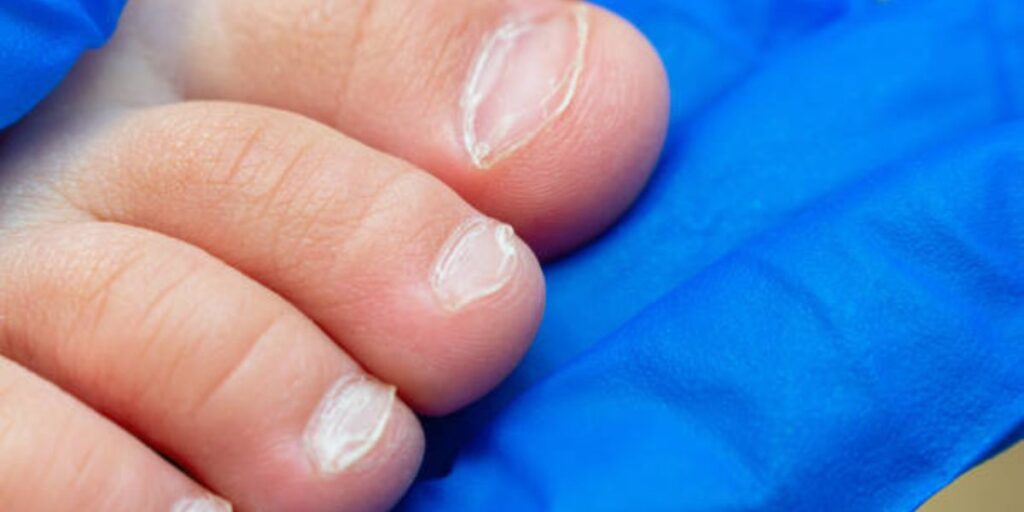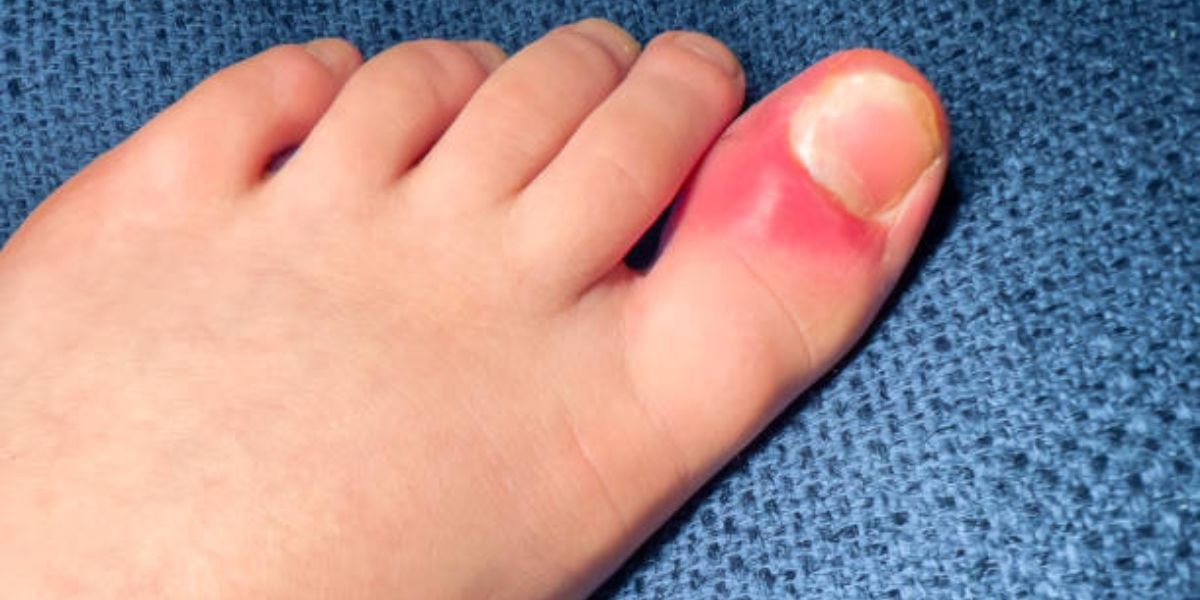Fungal nail infection in children is a growing concern that many parents overlook until it’s too late. Though it’s more common in adults, children can still suffer from pediatric nail infection, especially when exposed to public places like school gyms or swimming pools. The condition, medically known as onychomycosis, occurs when a dermatophyte fungus invades the nail bed, often leading to child nail discoloration, brittleness, or thickening. Unlike adults, kids may not express discomfort clearly, which makes early detection harder. Identifying signs such as toenail fungus in toddlers or nail yellowing can help start treatment early. With proper hygiene and guidance from a pediatric dermatologist, this stubborn infection is treatable.
What is a Fungal Nail Infection?
A nail fungus infection, medically called tinea unguium, happens when dermatophyte fungus invades your nail. It can affect fingernails and toenails, though toes are more common. The fungus grows slowly under the nail, causing thickened toenail and yellow toenail discoloration. Over time, the nail may turn brittle, lift, or even have nail pain and swelling.
Doctors follow the USA CDC nail infection guide to understand how widespread it is in the U.S. They see many cases in older adults, but pediatric nail infection is rising too. The infection often starts in damp places like shared showers or on wet shoes and fungus left on the feet.
Symptoms of a Fungal Nail Infection
You might notice a nail that has yellow toenail discoloration, blackened edges, or becomes fragile with brittle nails. Some people feel nail pain and swelling, especially when the infection is advanced. The nail may separate from the nail bed and develop subungual hyperkeratosis, where thick material builds beneath.
In many cases, the infection spreads slowly. You might not feel urgent discomfort, but nails look odd and feel rough. At that point, it becomes real. Early detection helps reduce the risk of recurring nail infections.
Pediatric Onychomycosis: Fungal Infections in Children
Kids can get onychomycosis too. Kids toenail fungus is most common in school-aged children. The culprit is often the same dermatophyte fungus that infects adults. But for kids, barefoot in public showers and school locker room infections are major risk factors.
Parents often ignore child nail discoloration until toenails look thick or smell bad. When those signs arise, pediatricians may refer them to a pediatric dermatologist. Treating fungal nail infections in children early prevents more serious cases.
How is Pediatric Onychomycosis Diagnosed?
A doctor starts with visual inspection—looking for signs like discoloration and nail thickening. Then they might request a fungal culture test or nail biopsy for confirmation. These tests help differentiate fungus from other nail issues.
Sometimes an onychomycosis diagnosis is confirmed only after lab results. Samples come from the nail plate or under the nail. If needed, doctors may use a telehealth dermatology appointment to assess hard-to-reach patients or get a second opinion.
Symptoms of Nail Infections in Children and Teenagers
In kids, nail infections often begin with mild thickening or slight yellow toenail discoloration. Parents may see blackened nail edges or detect rough texture when touching the nail. Some teens complain of mild tenderness while playing sports, especially if the nail rubs against a shoe.
While symptoms seem small early on, untreated infections might worsen. That’s when a pediatric nail infection becomes more painful or more noticeable, especially for active children or teenagers in sports.
When to Seek Medical Help for Nail Infections
It’s time to act if you see sudden nail lifting, lots of soreness, bleeding, or pus. These are signals that infection has advanced. Home treatments might not suffice in such cases. You should visit a podiatrist for fungal nail or a fungal infection specialist.
Children should see a doctor if their nails hurt, or if thickened toenail keeps getting worse despite home care. Delaying treatment in kids can lead to nail deformities and recurring infections.
Treatment Options for Fungal Nail Infections
Medical professionals use several methods. Topical antifungal cream and over-the-counter antifungal products are common first steps. You can apply medicated nail lacquer directly to the infected area daily.
If topical treatments take too long, doctors may recommend oral antifungal treatment like fluconazole for nail infection or terbinafine cream. For stubborn cases, they may advise laser treatment for nail fungus. Some adults also explore natural remedies for nail fungus, such as tea tree oil for nail fungus.
| Treatment Type | Pros | Cons |
| Topical antifungal cream | Low side effects | Slow work, may not reach fungus |
| Oral antifungal treatment | More effective for severe cases | Possible side effects, liver checks |
| Laser treatment for nail fungus | Faster, non-invasive | Expensive, not FDA-approved yet |

Treating Pediatric Fungal Nail Infections
Treating fungal nail infections in children requires gentle care. Many doctors begin with topical antifungal cream and medicated nail lacquer. If those don’t work, they may prescribe an oral antifungal treatment at a lower dosage.
Parents must clean and dry the child’s feet daily. Keep nails cut short and inspect them often. If symptoms persist after weeks, a pediatric dermatologist might adjust treatment or suggest more advanced options.
Role of a Pharmacist in Treating Nail Infections
A pharmacist offers vital pharmacist advice on selecting the right over-the-counter antifungal product. They can explain how to use medicated nail lacquer or suggest oral antifungal treatment options if needed.
They can also alert you when symptoms require escalation. When treatments fail, they’ll recommend a podiatrist for fungal nail or a tinea unguium specialist. In the U.S., pharmacists also guide on insurance-covered prescription nail treatments.
Preventing Nail Infections in Adults and Children
If you want to avoid toenail fungus, maintain a strict nail care routine. Keep feet clean and dry, avoid going barefoot in public showers, and never share nail tools. Change socks daily, and let shoes dry completely before wearing them.
Encourage your child to wear flip-flops in locker rooms. Use well-fitted shoes and avoid wet shoes and fungus. A balanced diet helps too—vitamins boost immunity, reducing the risk of recurring nail infections.
For More Information For Visit Us:
Conclusion
Fungal Nail Infection and Pediatric Onychomycosis can affect anyone. With early diagnosis, proper antifungal medication, and good foot hygiene, you can treat and prevent outbreaks. Stay alert to signs like yellowing, thickness, or pain. Consult pharmacists, podiatrists, or dermatologists. Most cases improve with care.
FAQs
How do you treat fungal nail infection in children?
Topical antifungal creams or medicated nail lacquers are usually used; oral medication may be prescribed in severe cases.
How do you treat an infected nail on a child?
Clean the area, apply a doctor-recommended antifungal cream, and consult a pediatrician if symptoms persist.
How do you treat fungal infection in children?
Mild infections are treated with topical antifungals, while persistent cases may need oral medication under medical supervision.
What is the fastest treatment for fungal nail infection?
Oral antifungal treatments like fluconazole offer faster results, though laser therapy can also speed up recovery in some cases.
Welcome to Heel Tooth! I’m Lee Marvin.

